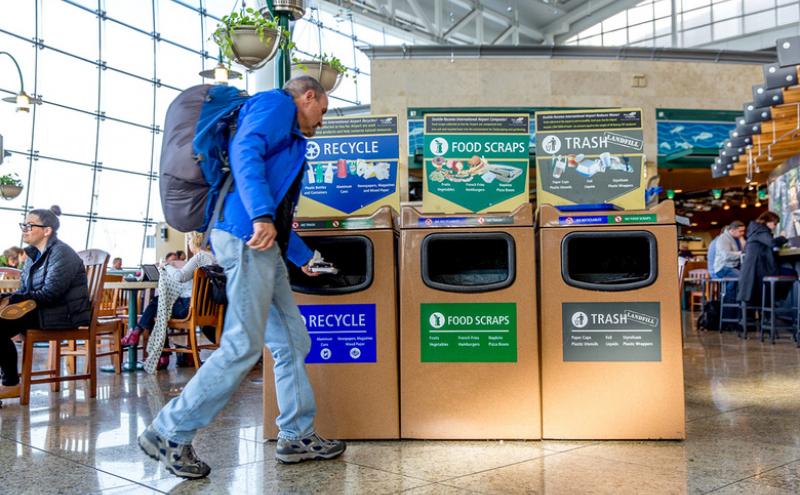
How Sea-Tac reduces daily waste – and how travelers can help.
Every day an average of 1,045 flights arrive at and depart from Seattle-Tacoma International Airport. Every day an average of 125,000 travelers fly through Sea-Tac — many of them grabbing a quick drink or bite to eat along the way.
To manage the mountain of garbage left behind by all those people, the airport has been working for nearly 25 years to reduce, reuse, and recycle.
Last year Sea-Tac’s passenger terminals generated 7,320 tons of trash, according to the Port of Seattle, with 87 percent coming from concession stands, public areas, and disposal of passenger trash from airplanes.
Thanks to Sea-Tac’s Waste Minimization Program, established in 1993, a good deal of airport trash gets recycled or, composted. Last year, one-third of all airport trash was kept out of the landfill.
How exactly does the airport do it? Jeremy Webb, who leads the Port of Seattle’s Waste Minimization programs for Sea-Tac, shares their top strategies.
- Providing recycling bins in all public areas. Hopefully you’ve noticed the many recycling receptacles for cans, bottles, paper and compostable materials — all well-marked for easy sorting — alongside the trash bins throughout the airport. But airport recycling bins aren’t just available to travelers. The airport’s employee offices and leased spaces contain them, too.
- Offering water refill stations. Water bottle refill stations beyond airport security checkpoints encourage travelers to fly with their own reusable water bottles. Liquid drain stations at security checkpoints allow passengers to drain liquids and either recycle their container or save it for refill after security (using the water bottle refill stations). The Port of Seattle estimates these refill stations prevented 10 tons of disposable water bottles from clogging landfills last year.
- Requiring concessionaires to recycle and compost. As of 2017, airport pubs, eateries and retailers must sort their trash for recyclable and compostable materials. And if they’re not serving drinks and meals with reusable dishware and silverware, they must provide customers with airport-approved compostable or recyclable service ware.
- Repurposing cooking oil and paper towels. Last year, the program converted 71 tons of used cooking oil from airport restaurants into biodiesel fuel. Similarly, the program converted used paper towels from the restrooms of the airport’s administrative offices into a nutrient-rich soil additive for gardening and landscaping.
- Making recycling free for airport tenants. The airport’s free recycling program and fee-based garbage disposal service give airlines and concessionaires extra incentive to reduce the amount of waste generated during operations and sort their trash.
- Recycling construction waste. Building contractors working on airfields or in terminals must sort and recycle their construction and demolition debris. Over the last two years, this has led to an annual average of more than 370,000 tons (or more than 90 percent) of construction waste being diverted from landfills.
- Donating extra food. The airport has been funneling surplus meals from concessionaires to local food banks for the past decade. In 2016, the program donated 56,972 pounds of nutritious, ready-to-eat food to the local food bank – that’s 876 meals a week for people in need.
All these efforts require airlines and airport vendors, contractors, employees, travelers and visitors to do their part, Webb stresses.
“We’re basically one big family,” he added. “We’ve all got to work together.”
So how can you help? Here are a few easy ways to start.
- Invest in a reusable water bottle. Stop buying a plastic bottle of water each time you fly and start taking a reusable plastic, glass or steel water bottle with you. Sea-Tac’s water bottle refill stations make it easy to refill your bottle after going through security.
- Only take what you need. Do you really need that straw or more than one napkin for your coffee and muffin? Or three packets of ketchup for your burger? Be mindful of how many dining accoutrements you grab. You can always go back for another packet of salt later or ask for an extra napkin on the plane.
- Sort your waste. It’s never too late to get in the habit of sorting your trash. If you haven’t already, the next time you’re in one of Sea-Tac’s airport terminals or eateries, acquaint yourself with which items go in the clearly marked garbage, recycling and compost bins.
- Push your airline of choice to recycle. Alaska Airlines is known for sorting through the trash left by its passengers for paper, plastic cups, glass bottles and other recyclables. But not all airlines do this. No matter which carrier you fly, let them know that recycling is important to you.






